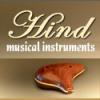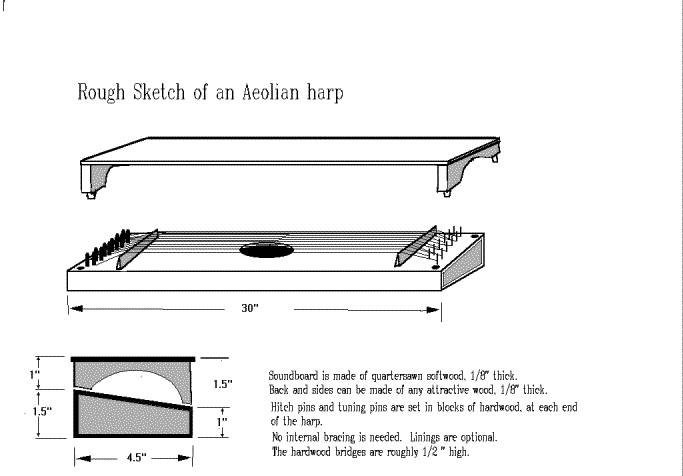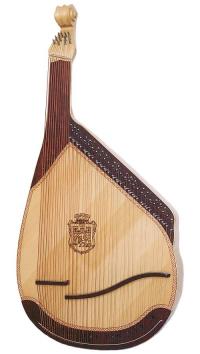Search in CMI:
Richard Waters, inventor of the waterphone demonstrates various techniques of playing the megabass waterphone
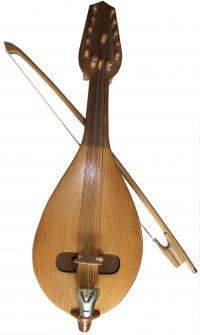
The name means "to make noise, hum or buzz". The gadulka is an integral part of Bulgarian traditional instrumental ensembles, commonly played in the context of dance music. Sometimes referred as the "Balkan fiddle"
sample mp3(streamed from balkanfolk.com ) so you can make an idea how it sounds like
The resonance chamber is pear shaped similar to a lute forming a bowl or gourd and it's often carved out of a single piece of wood. The player holds it up right hanging from the belt or on the lap if sitting. Of byzanthine procedence it is rather similar to the Greek lyre. Gadulka strings are steel, either plain in the smaller gauges or wound with steel or bronze in the larger ones; they are basically guitar strings. The strings are secured to the tailpiece by their ball ends!It has three melody strings and up to 16 strings thinner metallic steel sympathetic strings that make resonance upon the tones, making the gadulka sounds more clear (the natural sound of gadulka is quieter than the violin though less crispy and pleasant to the ear). The strings are played with the nails. The tone of the gadulka is obtained by gliding the strings with the bow made of flexible forked willow twig and tied with horse hair and waxed with rosin.
Unlike many other stringed instruments, there is no nut at the top of the strings: the strings are simply stretched between a tuning peg at the top and the tailpiece at the bottom, passing over the bridge (the playing strings) or through holes in the bridge (the sympathetics). The tailpiece is typically made out of bone, and secured to the carved projecting "end pin" by stout steel wire. The end pin also serves to hold the bottom of the instrument to a strap or belt worn by the player. It is bowed with an underhand grip.The top (soundboard) is also carved with a shallower arch. The overall construction is quite heavy compared to, say, a violin, though some gadulkas are exquisitely built. The instrument generally lacks any real decoration or ornamentation, apart from the design of the peg head.
For more information we recommend to read as always the Gadulka wikipedia article
In Bulgaria it's used in folk traditional and ritual songs.Though apparently crude and unwieldy, this instrument is capable of great heights of technique and sensitivity in the hands of such masters as Nikola Parov, Giorgi Petrov or Mihail Marinov. In Bulgaria it is usually played in ensembles with the kaval (end-blown flute), gaida (bagpipe) and tambura (a type of guitar) or tapan (a large drum). Dance rhythms range from the relatively straightforward 7/8; to the 11/8 Kopanitsa to even 22/16
Tuning
While various tunings are (and have been) used, the standard tuning for the gadulka is A-E-A for the three melody strings a pitch that gives more opportunities for solo instrumental performances but the tuning differ in different regions; the sympathetics (resonating strings) are tuned chromatically to cover all notes besides A and E
The 3 stringed Gadulka is pitched normally in these different regional ways: Thracia tuning: 1st string – A1 2nd string –E1 3rd string – A, Dobrudja tuning: 1st string – A1 2nd string – A 3rd string – E1 or Lingourie tuning: 1st string – A1 2nd string – E1 3rd string – D1

Example of gadulka tuning with three melody string (black) and 10 resonance strings (in red)
Only the upper strings are bowed while the other strings accompany only to resonate the sound rendering that echo-like haunting sound of the instrument.
Teaching yourself..?
We recommends "The Gadulka book" a book that includes the history of the instrument, its regional types, shapes, tuning scales and techniques including a lot of graphical material for easy learning. You can purchase this book from the store at Folk Factory.
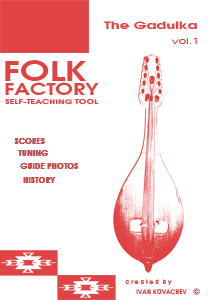
Below you can see a video of a gadulka being played
Where to buy
In ebay you can find some gadulkas listed, from kid very cheap ones to actually playable instruments. Be sure you don't buy a souvenir one, that can go really cheap but though make sounds are not ready to be played.
- Ebay (here you can find a few playable ones for quite a bargain price... but beware souvenirs!!)
Check also these stores, they specializes in Bulgaria culture and instruments and list them :)

Above: Gadulka available at Balkan folk
I don't know the quality of these instruments or if they're playable, so I recommend to contact the sellers directly before purchasing, they are just links I've found when looking for gadulkas for myself. Hope to have one soon to make a proper review. We´ll keep on adding information about instructional material and where to buy them on future updates.
Need more inspiration?
Visit the website of the master gadulka player of traditional Bulgarian music Nikolay Kolev
Paul Marshall youtube channel includes several how to make inexpensive overtone flutes and fujaras (slovak bass overtone flute) out of PVC pipes. If I were crafty I'd be trying right away, and even not being I feel quite tempted to try. I was gifted an overtone flute by my friend Corwen and I saw how easy it turned out to be made and how in tune it actually plays. So here I leave you with a couple of videos.. if you love the overtone sounds and have a limited budget on your pocket, then check these videos:
A follow on from the overtone flute makling episode. This time I pay some attention to the sharp edge to generate a clearer note
The much requested details on how to control the airflow for this great sounding instrument based on the Slovakian Shepherd's Overtone Flute the Fujara
.
Here I leave you a video with some tips of how to play an overtone flute by Max Brumberg... tips and basic technique in five minutes
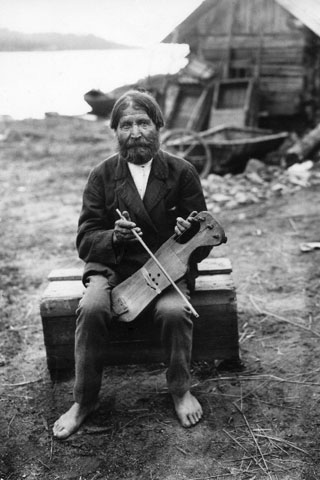
Feodor Pratšu playing Jouhikko © Museovirasto
Jouhikko (pronounced yo-hee-ko) is the name given to a distinctively type of bowed lyre from Finland and Karelia (an instrument old as human civilisation itself) though it resembles in some ways types of Baltic Psaltery from further east such as the Slav Gusli, and types of psaltery/lyre hybrids found in the archaeological record from Novgorod, Opole etc. It may be descended from these instruments rather than from the Round Lyre, strictly speaking this would make it a bowed psaltery rather than a bowed lyre, but whether a psaltery with a hand hole should be re-categorised as a lyre is a matter for musicologists... The origins of the jouhikko remains still a bit obscure, though obviously ancient.mPerhaps the earliest definite depiction of this kind of instrument is the stone carving from Trondheim Cathedral, Norway, dating from the second quarter of the 14th century Jouhikkos are usually strung with horsehair string,
It is related with the Finnish instrument Kantele that we previously covered in another CMI article.

Above: Alto jouhikko kit available at Ancient music (UK)
I have myself an alto Jouhikko I purchased from Kate and Corwen from Ancient Instruments (UK) -by the way very talented couple themselves- and by far the most affordable source for the quality of the instrument. As a lover of the kantele the jouhikko makes an excellent couple to this other instrument being partners in many pieces of finnish music. This is a video of Corwen himself explaining a bit of the instrument:
Learning to play it:
First you need to hold the instrument upright between the knees. The typical Jouhikko has a long, narrow outline, with only a small hand hole which is offset to one side, allowing only one of the three strings to be stopped. There are Jouhikkos with two strings only but they normally have three being the middle string is a drone, the string furthest from the hand hole is used to play the first note of the scale.
The bow need to be moved parallel to the bridge and trying always to bow the drone sting and bass or melody string in a sort of of bouncing movement. The jouhikko only has a range of six notes. You can change the note by stopping with the back of your fingers (traditional way) or with the inside of the fingers if you place your handover the first string (melody) in order to be able to change the drone with the knucles (for intermediate players). It takes some time and practise to play the notes relaibly in tune, and also the instrument tend to come out of tune quite easily, so it helps that you have a good ear and get fast enough with the microtuners (a recommendation if you purchase this instrument)
Most Jouhikkos are in D key (with a tuning of D - A - E (being D the bass, A the drone and E second note on the scale). In alto jouhikko (A - E - B) You can play typically a major and minor scale. As you can see in the following video showing you the basics of how to play the jouhikko by performer Pekko Käppi.
Above: Video explaining how to play scales in the jouhikko
If you purchase it from Ancient Music , it comes with a little print brochure in english called "introduction to the Jouhikko" written in english with the basics to keep and start to play your instrument. Though brief, it´s consistent and carry quite a lot of information and background.
The actual reference to learn to play this instrument is The Bowed Lyre Book is a visual guide and tutorial book written by Rauno Nieminen
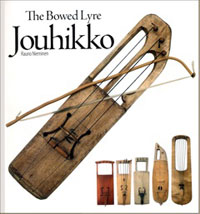
Above: Book: The Bowed Lyre Jouhikko
Written in Finnish on one side and clear English on the other. The book has the history, playing and setting up guide for the It includes a cd of rare archive recordings of the last players of the old tradition in Estonia, recorded on wax cylinder/phongraphs, though old and scratchy in sound in combination with the included written notation it provides much information.The book is available from Finland through the Finnish Music institute (37 Eur + shipping) or you can read more info from Rauno's website:
http://raunonieminen.com/sivusto/
For beginners (as myself) I also highly recommend to visit this Jouhikko website, though it's in finnish you can easily use an online translator, and it has even some videos and lessons of basic traditional jouhikko music as example, as well as explanations about the history and the instrument parts and construction. You can even play "online" the jouhikko in the website interface :) to understand how it works and videos to play the same melody in different styles with examples.

Above: How to hold the jouhikko bow (explained this jouhikko website). You can add a bit of pressure with the thumb to make the string of the bow tighter. Remember always to put rosin on your bow before playing (to avoid scratchy sound)
I confess I never had experience with bowed string instruments before... and I did know it was going to be complicated but though it's quite difficult to evolve fast (at least for me) it's rather easy to get started and this is quite encouraging. Gerry Henkel from kantele.com that also had made some jouhikkos himself told me... that they are like a horse that need some taming and that the jouhikko finally decides to sing for you itself. And he's right. There´s something really ancient and earthy and and primitive n the way these horse strings sound somehow rather dense like a rudimentary viola. Nothing as clean and polished as a violin but indeed a sound of other times settling in nordic folk music.
Jouhikkos are in the midst of a potent revival in Finland and is being incorporated in modern bands as well (including me LOL!)
You can read more information in the Jouhikko wikipedia article
- Finnish site about the Jouhikko
- Jouhiorkesteri
- Finnish Jouhikko maker
- Estonian Jouhikko maker
- Eric and Corwen English Jouhikko maker
- Russian Jouhikko maker
- More info on Simon Chadwick's Jouhikko with photos, audio and video demonstration
- Rauno Nieminen's official website
Above: My kantele (made by kantele.com) and my alto Jouhikko (It works well tuning it to G, A or Bb Key) (from Corwen Ancient Instruments) , a pretty couple of traditional finnish instruments. High D jouhikkos are the most commonly found.

Huge and rather rare looking... a mix of retro and futuristic design the Paetzold recorders ( Paetzold Bassblockflöten) are one of the largest recorders ever made with an unusual appearance and a deep sound, made in 4 parts the keys are made of flat pieces of wood. And inspired in organ pipes, the tube has an "S" and not straight allowing a longer column of air.
There are different versions going from Bass, to Sub-bass and contrabass model. A visual explanation and description is shown in the video below:
In this site you can see how these recorder fingering works
The range of Paetzold square bass recorders is the same as standard bass recorders approximately two octaves (A-440). Four sizes are now available a bass (new) in f, a greatbass in c (an octave below a tenor), a contrabass if F (one octave below Even on the lowest bottom notes, is very strong, in contrast to many other maker's low instruments. The instruments speak easily over the full two-octave range. Articulation is quick and light. They all have double keys for the bottom two notes. A hard case and a stand is available for each instrument. Although they are indeed not cheap a square bass recorder can be half the price of a traditional bass recorder, and we don't need to say that there are also larger models than can go lower in tone.
The waiting time for delivery is two to four months.
If you want to know more or simply purchase one I recommend you the german site that is specialized in Paetzold recorders from the maker Herbert Paetzold
Where to buy one:
As first point to see as I said check Herbert´s site at http://www.alte-musik.info.
If you're based in Europe you can buy one for example from some big music stores Thomann.de (based in Germany) they sell to several countries in the continen. There you can get a Paetzold contrabass recorder available from Thomann.de store ( Subbass recorder ) F in 3 parts, a'=442 Hz, chromatically playable over 2 octaves , square construction, size: 152 cm, height of the air column ca. 175 cm, birch plywood, 2 pitch plates, incl. case, normally played whilst seated.
From England you can purchase it from The Early music Store
These recorders are now distributed in the US by the Boulder Early Music Shop
The sound indeed is very deep and somehow even mystic, and a lot of effects can be done including beatboxing making all sorts of unusual sounds.
In this youtube video you can dive into the deep sound of this recorders
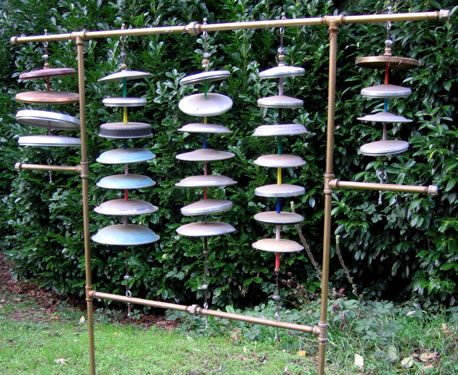
The Aquaggaswack is an odd music instrument with an equally odd and difficult to spell name. This interesting musical instrument was first made as mentioned by Curtis Settino, being composed of a medley of unique household instruments, all hung from a framework of metal galvanized plumbing pipes in a way easy to assemble and break down into pieces to be easy to transport.. First version was built in1996 and it was featured in an issue of Experimental Musical Instruments back in December of 1998. A good example of how to create music recycling materials.
The first version of the Aquaggaswack dated in 1996 was narrower and only had 18 pot lids and no outer sections. The second and improved version was made in 1998, with 29 pot lids representing a majority of the notes in an octave, plus some quarter-tones. The center lids have mostly "bell"-like tones and the outer sets have a more "gong"-like tone. All the lids were obtained from thrift stores and friends and can be played with mallets, sticks and brushes. At various times both versions of the Aquaggaswack also included a cymbal, jingle bells, a cowbell with clacker and a mine cylinder
In Spain is currently known as "Carrillón de tapaderos" and you can read some guidelines about how to make your own one in this article (Spanish)
And if you are wondering about how it sounds like... and looks like in action you can watch the following video.
The fact that you can find inexpensive tin whistles for a couple of dollars doesn't mean that a true and well made one hasn't to be a precision item. Michael Burke has devoted his skills to hand craft instruments with clear tone, balanced and in tune in two octaves. Committed to make the finest professional penny whistles out there this small company based in USA and run by Mr. Burke self and his wife was the answer to my search.
Not a long time ago looking for a low whistle (lets say a tin whistle with a pitch lower than Bb) was really a hard task, and when found it was only the Low D. I felt a little bit scared to try as my hands are small and it the slow whistle is too large holed or the stretch too big, then it was an impossible thing no matter how relaxed I was. Then I found my Burke Low D whistle and I was happy ever since. seriously.
But sure you can find higher keys, in fact "ANY" key! :)
.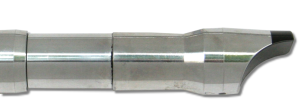
Detail of the Low whistle
The instruments are made with great care. The body is cylindrical and the sound is clear, clean and sweet. As owner of quite a few low whistles, I fell in love with my Burke. I do know you'll be pleased and will never regret your house. It's the one I use most and definitely the one I possess I love the sound most... and I confess I would have not complaint to have more keys. Lightweight, well balanced, easy to grip and quite gentle to the small hands one mine with a split low D piece.
They also have a lot of models in stock in a wealth of keys reducing your wait time and make effort to ship your order as soon as possible. I wish I could grab quite a few of them... But I know in some time soon I'll replace my actual high D whistle for a Burke one too.
Most of the models are offered in different keys and in Brass, Aluminum and Composite, depending of the kind of sound you're trying to achieve. Brass is sweeter and Aluminum is louder. You can watch this video where they compare different burke whistle materials and the size of the holes so you can make a decision of what kind of sound you're looking for.
I also recommend to opt for the thumb hole. I opted for this and never regretted. Explaining what it is in a standard D whistle this option is a way of providing a perfect C natural on your D whistle so that you can play in the key of G or other scales that need a flattened 7th. It also allows you to get an octave C natural on the D whistle as well, to extend the scale and also to add options for ornamentation. The extra tone hole is located on the back of the tube between the top two tone holes and the note is played by playing a "B" and lifting the thumb. If you keep your thumb in place, the whistle will play exactly as a regular 6 holed whistle. The option is available on any model in any key. This is a great option that allows you a very accurate second scale on your whistle. I also came from recorder playing, so somehow I was always missing it.
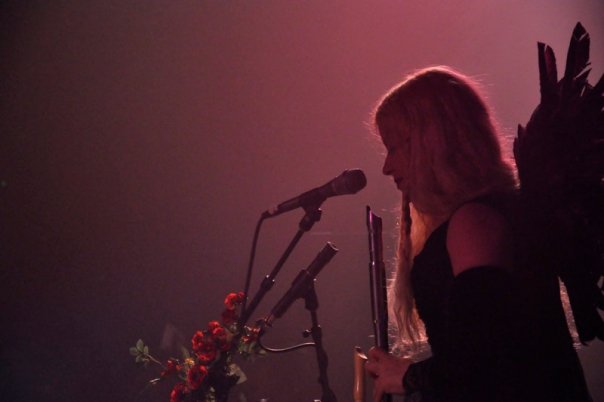

Above: me on stage playing a Low D Viper Aluminum Low D Burke Whistle.
I've already recorded quite a lot of songs with it for the new album, so will upload some excerpts very soon. I tell you that the Irish whistles are instruments very versatile and not only for traditional Celtic style.
![]()
The Viper Aluminum Low D is the most powerful and loudest low D they make It has moderate back pressure, a very big and powerful low end and great balance in sound between the octaves. The second octave is very accessible with moderate blowing and this low D can be used to play any kind of music at any speed as can be shown in our sound sample. By the way it's available in Low C too (SIGH!)
I recommend you also their handy roll case with slots for different keys, affordable and really useful
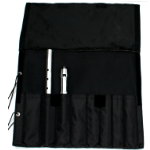
And you can listen samples of most of the whistles available at BURKE WHISTLES official website

Above: Aeloian harp made by Harp Maker
The Aeolian harp (read the wikipedia article ) is named after Aeolus the ancient greek god of the wind. They're sometimes called "harmonic harps". They originated in ancient Greece and flourished through the Renaissance era becoming very popular n the Romantic Era. The traditional aeolian harp is essentially a wooden box soundboard with strings stretched lengthwise across two bridges. It is placed in a slightly opened window where the wind can blow across the strings to produce sounds. The strings can be made of different materials (or thicknesses) and all be tuned to the same pitch (some are called "monochords") or identical strings can be tuned to different pitches. The musical sounds of an Aeolian Harp are the results are of vortex "swirls" flipping around in the back of the strings It's somehow misterious but also ethereal, haunting and inspiring. Aeolian harps are still hand-crafted today. Some are now made in the form of monumental outdoor metal sound sculputures. In fact if you place a standard up in a windy hill you will most likely hear this eerie ghostly wind moans.

Above: Outdoors Aeolian harp sculpture in California
So how does it sound untouched by human fingers?
-Click here to listen a livestream of an aeolian harp at the University of Ulm (Germany).
-Internet radio broad cast with sounds of the wind harp
Wind harps transpose the spirit of the wind into spontaneous, multi-layered music in time to nature's rhythms. Their vibrant voices sing pure harmonic tones that range from deep, pulsing bases to soaring sopranos.The sound is random, depending on the strength of the wind passing over the strings, and can range from a barely audible hum to a loud scream. If the strings are tuned to different notes then sometimes chords can be heard.
Below: Video of wind harp recorded it on a beach in Pembrokeshire, West Wales. The sounds are created randomly by the wind vibrating the strings. This is a track from my CD Windharp and Wavesong that you can find at nickpenny.com
Raw recording (with no effects added) of wind on a standard harp producing a similar effect.
There are some builders that go beyond making bigger outdoors sculptures that you can place in your garden. Harmonic wind harps make not only the typical door and window harps but also other bigger sculptures ready for outdoors, for example the weather proof harmonic sanctuaries that can accommodate several people, an unique auditory experience!
Above: Aeolian harp harmonic sanctuary
If you find these wind sounds healing or relaxing, then you can buy the cd Wind Songs is a distinctly unique CD, composed of eight tracks that feature a variety of harps, winds, and tunings. at harmonicwindharps. Sample of the album called "chakra tuning.mp3"
How to build your own aeolian harp
Maybe you're considering to make your own aeolian harp!
Feeling crafty...? making an aeolian harp doesn´t look so difficult... You can find already made plans to do it... or even improvise it. I'm about to try it myself so I´ll come and edit to inform you of my progress
The below graph was taking from this link where you can commission yours or see some pictures of the process on the making
The above drawing of an aeolian harp was drawn by Bruce Taylor (using Windows Paintbrush) and posted on rec.music.maker.builders many years ago.
You´ll need zither pins and nylon strings that you can easily find in ebay and also any music local luthier or instrument music store. Remember that the longer the harp is, the more easily it will sing in light breezes. You find some plans also to build it in ebay.

Above: aeolian harp woodworking plan
Here is a link to Harpmaker.net book "Building the aeolian harp" that is sold electronically and consists of a step-by-step tutorial explaining the complete process from material selection to tuning the completed harp and getting it to sing for you. It includes 19 drawings, 22 color photos and all the information you will need to build your own harp.
And in this other link you can also read an indepth article about aeolian harp and read how to make your own with illustration: how to build an aeolian harp
As you see in aeolianharps.com aside of the classical aeolian harps they make other models, including with plastic bottles and chairs... and also combining it with other actual and playing instruments like this example:
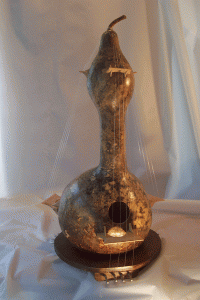
Above: Gourd harp made by Aeolianharps.com
B7WET7MYVXUP
The Bandura is the national instrument of Ukranie and a potent symbol of this country. The instrument is also also pretty popular in Russia. The bandura combines the elements of a lute and a psaltery.
The metal strings are played open with the tips of the fingers and nails in a manner similar to the harp. The sound when plucked is really exquisite and somehow bright between the sound of an harp and harpsichord. It produces deep single bass string patterns, also is characteristic the offbeat chords played by the right hand alternating with the bass notes, sweeping chromatic flourishes and ornaments on the upper high pitched strings and tremolo effects rubbing the fingers in the high pitched strings too
Above: Bandura played by Natalia Golub.
The bandura is a multi-stringed Ukrainian folk instrument. The great majority of banduras found to purchase range from 36 strings to concert professional ones that can have up to 68 chromatically tuned strings (through 5½ octaves).Though used most in folk music the instrument is used in large ensembles however it is an effective and mesmerizing solo instrument and is also sought after as an accompaniment to vocal groups of various kinds and composers. The strings are plucked with the ends of the fingers and nails, giving the instrument a slightly metallic sound, like a cross between the harp and the harpsichord. The back is usually dug out of a single piece of willow, while the front soundboard is of spruce. Played when seated, the left hand usually wraps around the top of the bandura to pluck the bass strings while the right reaches across to play melody or chords on the higher pitched strings, as seen in the following picture.

Banduras were first mentioned in 6th century Greek chronicles as a type of gusli (a russian instrument very similar to the kantele). The modern instrument can more precisely be said to derive from a lute-like instrument. called the kobza, dug out from a solid piece of timber. This became extremely popular in Ukraine and beyond during the era of the Ukrainian Kozaks/Cossacks (16th-18th centuries). During this time the instrument underwent certain structural changes such as the addition of secondary strings along a widened soundboard, which later became one of its distinguishing features.It was then where a special class of musician called kobzar emerged. These were the Ukrainian equivalent of the troubadours of France and typically blind. The kobzars sang epic ballads called dumy about the exploits of the Kozaks against foreign invaders, reminding the people of their past glories and tragedies. They accompanied themselves on the bandura, which gradually developed into the instrument pictured above and they were normally blind. The bandura was alsotraditionally played by soldiers and it was a compulsory instrument to play. Whenever soldiers were wounded and couldn't fight anymore, playing the bandura became their profession. At the beginning of the XX they were thought to be all dead but the instrument rescue was promoted and it experimented a revival later in that century thanks to Hnat Khotkevych managed to find a small number of them and reinvigorated the tradition through promoted performances. The bandura became extremely popular, being taught in many music schools and conservatoriums, as Ukraine enjoyed a very brief period of independence at the end of World War One and also some autonomy during the early period after forced incorporation into the USSR . In the 1930s, Soviet authorities took measures to curtail national aspects of Ukrainian culture (see Russification). This included any interest in the bandura. Various sanctions were introduced to limit cultural activities that were deemed nationalistic. When these sanctions proved to have little effect on the spreading of such cultural artifacts, bandurists often came under harsh persecution from the Soviet authoritie. But after that period players were rehabilitated and Oochestras of banduras were formed, and they were also incorporated into otherwise Russian folk orchestras of domras and balalaikas.Many Soviet Ukrainian composers wrote serious, complex works such as full length sonatas and concertos for bandura during the 20th century plus many arrangements of and variations on Ukrainian folk songs and dances.
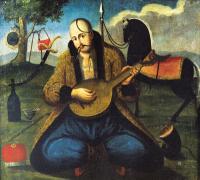
Above: Kobza bandura player
During it’s evolution it was used by traveling minstrels or kobzari to accompany their story telling – usually these stories were of epic kozak battles and heroic deeds while facing invaders of the Ukrainian homeland.
Some recommended links
-I will recommend you (if only for historical reasons) and also for details of different models and evolution (from fretted to unfretted) of the instrument to read very complete information about the Bandura in wikipedia.
-Here you can see a blog of a bandura maker so you can see pictures of the making of process.
-Article about traditional folk ukranian instruments
Where to buy one:
I keep investigating further on this so I'll update soon, so far Ebay does list banduras regularly, though scarce I've seen listed some rare very expensive vintage ones and some affordable student models too. If you don't find any keep on checking because some sellers often re-list the item. Below you can see an example bandura found in bay.
I found also this ukranian luthier called Trembita Guitars that sells Banduras directly from Ukrania.(Lviv)
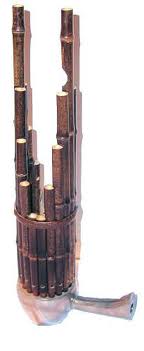
The Sheng ( 笙 pronounced "sung" and also called "Chinese mouth organ" in western culture) is one of the oldest Chinese instruments whose manufacture and use were documented in ancient history. It first appears in 551 BC during the Zhou Dynasty (1111 to 222 BC) but there are records of similar ones back to 3000 years ago

The Sheng
The instrument is a mouth blown free reed instrument. In fact, the Sheng is the first musical instrument in the world utilizing a "coupled acoustical system," between an air column and a free reed.The traditional Sheng is made up of 13 or 14 pieces of vertical pipes of different lenghts mounted together on to a base, but the number of reeds of the modern Sheng varies from 21 to 32 being 17 rather popular. As the Sheng can produce chords as well as single notes, it is used as both a solo and accompanying instrument. Its pleasingThe base is traditionally a gourd-shaped, wooden wind-chest. Each bamboo pipe has a free reed made of brass. Music is produced by blowing and sucking the air through a metal tube connected to the base the air then rushes through the other pipes.

Above: detail of Sheng pipe
A player determines the notes to play by allowing the air to rush through selected pipes while pressing on selected keys near the base. By covering two or more holes on various pipes, chords are possible, being a typical technique used in most regional orchestras of China.
Example of live solo in concert. he SHENG is used as both a solo and accompaniment instrument.
How to play and fingering charts
Traditional ones often has 17 pipes tuned like this:
a′ b′ c″ c♯″ d″ e″ (2 pipes), f♯″ g″ a″ b″ c♯″′ d″′ or
A4, B4, C5, C♯5, D5, E5 (2 pipes), F♯5, G5, A5, B5, C♯6, D6
Chromatic keyed ones appeared half XX century.
Fingering charts for Sheng
- 17 reeds fingering chart (PDF)
- 21 reeds fingering chart (PDF)
- 24 reeds fingering chart (PDF)
- 36 reeds
- 37 reeds
(charts from Melody of China website)
Some links you may find interesting
- Wikipedia definition and history of the Sheng
- The Asian free reed mouth organ
- Pat Missin Shent article
- Firebird Youth chinese orchestra : non profit organization that teaches to play children the Sheng amont other traditional instruments
Sometimes you can find inexpensive shengs in ebay, but I wonder if they are playable... I'll update this article once I found this and other stores you could find one. It's a pretty popular item in chinese instrument trading :)

Above: example of inexpensive sheng found in ebay




